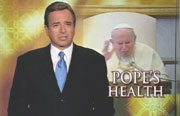Religion on TV News:
Table of Contents:
Executive Summary
 After all the dramatic events of last year’s religion news, from
the installation of an openly gay bishop and the 25th anniversary of
Pope John Paul II’s historic pontificate to Mel Gibson's movie The Passion of the Christ,
religion coverage on the broadcast TV networks could be expected to
decline. To measure the trends in religion coverage in 2004 and the
beginning of 2005, Media Research Center analysts surveyed every
religion news story on ABC, CBS, and NBC news programs in the 12 months
from March 1, 2003 through February 29, 2004. Major findings include:
After all the dramatic events of last year’s religion news, from
the installation of an openly gay bishop and the 25th anniversary of
Pope John Paul II’s historic pontificate to Mel Gibson's movie The Passion of the Christ,
religion coverage on the broadcast TV networks could be expected to
decline. To measure the trends in religion coverage in 2004 and the
beginning of 2005, Media Research Center analysts surveyed every
religion news story on ABC, CBS, and NBC news programs in the 12 months
from March 1, 2003 through February 29, 2004. Major findings include:
The trend of religion coverage declined measurably — until the Pope’s health scares in February. Religion coverage is down, but not as much as might have been expected. Overall, there were 648 total religion news stories in the 2004-05 study period, down from 705 religion news stories on the Big Three last year. The slippage came in evening news coverage, which fell from 292 a year ago to 228 this year. By contrast, the number of morning-show segments was nearly the same (331 in 2003-04, down to 320 in 2004-05) and the number of magazine and interview-show segments went up slightly (from 82 to 89). Without all the stories in February, the number of evening news stories would have been close to half of last year’s total.
The Catholic Church received the most coverage among faiths, but the percentage of Catholic coverage devoted to the aftermath of sex-abuse scandals has dropped. The health scares surrounding the Pope exaggerated the usual broadcast network tendency to focus on the nation’s largest religious affiliation. The church’s sex-abuse scandals headed toward the margins of coverage, with only 10 reporter-based stories on the evening news, or one-sixth of the stories on the Catholic Church. Last year, almost half of the reporter-based stories on the Catholic church – 35 out of 75 – focused on clergy abuse scandal news. The percentage of morning show segments was also one-sixth of the Catholic coverage, about the same level in the morning as last year.
Reporters approached religious issues from a very secular and political perspective, especially in stories on the presidential campaign. When some Roman Catholic bishops announced that they would deny Democratic candidate John Kerry the sacrament of the Eucharist over his decades of pro-abortion voting and advocacy, network reporters placed all their scrutiny on the church leaders, not on Kerry. Not only did they fail to explain the Eucharistic rules of the Church, they misquoted bishops as claiming Catholics shouldn’t “vote for sinners,” while they described Kerry as a “devout,” “observant,” and “practicing Catholic” despite his pro-abortion record. Kerry’s opponents were labeled “conservative,” but Kerry and his supporters were never described as “liberal.”
TV news often ignored religion news that the Religion Newswriters Association found were the top stories of the year. Surprisingly, after all of last year’s supportive coverage of gay Episcopalian bishop Gene Robinson, the networks barely touched the church trials of two lesbian Methodist ministers. During the study period, only NBC noticed the Christian ministers that have topped the list of best-selling books, especially Rick Warren’s The Purpose Driven Life, which recently entered the media spotlight after the Atlanta courthouse killings.
The MRC Special Report concludes with four ways the networks could improve their coverage of religion in the future: hire a full-time religion correspondent; hire reporters who are themselves religious; present the religious and theological dimensions of social issues instead of focusing solely on political elements; and present viewers with a balance of religious experts, not just a few favored (generally liberal) theologians.


